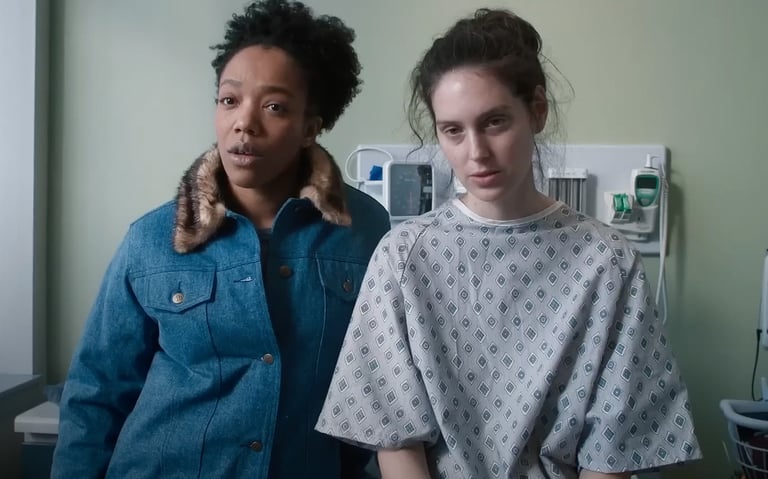Essays and Conversations on Community & Belonging
Sorry, Baby
Sorry, Baby plunges audiences into the darkly comedic world of Agnes, a professor "stuck" years after a sexual assault. The film's non-linear story mirrors her fractured psyche, powerfully highlighting the systemic failures she endures. A recurring motif, the bathtub, transforms from a space of private confession to a symbol of institutional blame and, later, complex intimacy. This stark trauma is contrasted with the healing power of human connection, seen in her deep friendship with Lydie and an unexpectedly profound encounter with a stranger, Pete. The finale, where Agnes holds Lydie's newborn, becomes a quiet vow to transform the world's negativity into a promise of positive grace.
QUICK POSTSMENTAL HEALTHSELF FULFILLMENTRESPONSE CONTENT
Alex Pilkington
11/12/20253 min read
The film Sorry, Baby presents a profound and darkly comedic exploration of the messy, non-linear reality of life after trauma. The story centers on Agnes, a college literature professor who finds herself emotionally stranded, unable to move forward years after a sexual assault she refers to only as "the bad thing." The film eschews the conventions of a typical trauma-focused narrative, focusing not on the event itself, but on the painstaking, awkward, and sometimes absurd business of a life attempting to heal.
The film's power lies in its nuanced and specific portrayal of the trauma's aftermath. Using a non-linear structure, the script mirrors Agnes's psychological state. We first meet her "stuck" in the present, still living in the same small New England college town, and the film gradually fills in the past. We learn that as a graduate student, Agnes was assaulted by her faculty advisor. This event is followed by a cascade of institutional failures; we witness her encounters with ineffectual university administrators and insensitive medical staff, systems that offer no justice, only further insult to her injury. The film never sensationalizes the assault; instead, it focuses on the chillingly quiet fallout—the lingering PTSD, the panic attacks, and the profound sense of stagnation that defines Agnes's existence.
A key setting for the immediate aftermath is a bathtub. It is from the bath that Agnes first tells her best friend, Lydie, what happened, recounting the assault in clipped, detached details. This scene juxtaposes the supposed comfort and privacy of the act with the horror of her confession. The bathtub's significance is amplified later, transforming from a place of private cleansing to a symbol of systemic failure. Agnes is reprimanded by a doctor for having bathed, as the act prevented the collection of evidence for a rape kit. This detail powerfully illustrates her predicament: a simple, human instinct for self-comfort is reframed as an error, complicating her path to justice and adding another layer of blame to her experience. This setting reappears later in the film, notably after a consensual sexual encounter with her neighbor. Her retreat to the bath in this context suggests it remains a complex space for her—one of private processing and perhaps a continued, subconscious refuge as she navigates intimacy in the wake of her trauma.
While the film is an unflinching look at pain, it is equally a testament to the power of human connection. The central relationship between Agnes and her best friend, Lydie, forms the story's emotional core. Their bond is palpable, built on a shared history and an intimate, witty rapport that provides Agnes with a rare space of unconditional support and grace. This light is also found in other, unexpected places: in the awkward but gentle kindness of her neighbor, and most notably, in a standout scene with a sandwich shop owner named Pete. After a triggering event causes Agnes to have a public panic attack, Pete, a stranger, calmly coaches her through a breathing exercise. He provides not just a sandwich, but a moment of profound, non-judgmental understanding. When Agnes confides that she is still trying to get over the "bad thing" from three years ago, he validates her feelings by simply stating, "Well, that's not much time." These small "grace notes" are not a cure, but they are a counterbalance, offering moments of understanding that help Agnes endure.
Sorry, Baby is a singular achievement in storytelling, finding its drama in the quiet, internal struggles of its protagonist rather than in grand, cathartic gestures. The story's offbeat humor, often stemming from painfully relatable social interactions, functions as a vital coping mechanism. It recognizes that even in the midst of profound pain, life continues to be absurd. By refusing easy answers, the film crafts a deeply moving portrait of what it means to be 'stuck,' and what it looks like to slowly, haltingly, and imperfectly begin to move on. This is crystallized in the final scene, where Agnes holds Lydie's newborn baby. She speaks softly to the child, acknowledging the "bad things" and pain that exist in the world she has just entered, but also offering her hope and support. It is a moment that perfectly captures the film's core idea: a quiet, personal ethos of acknowledging profound negativity and vowing to turn it into something positive—a promise to endure and offer grace to the next generation.





